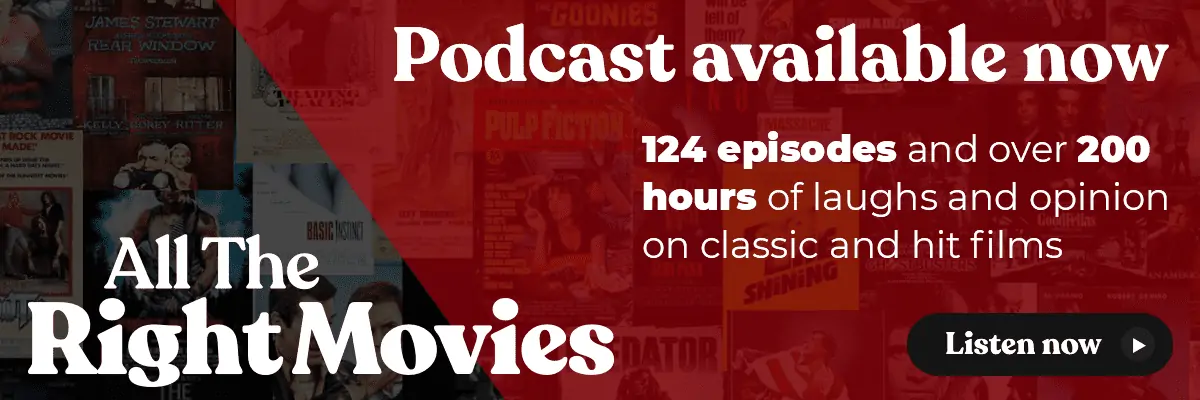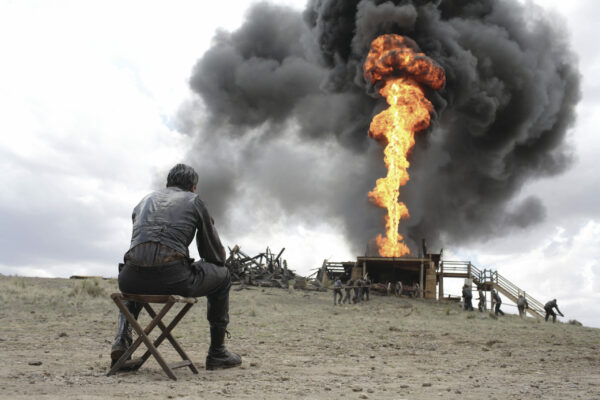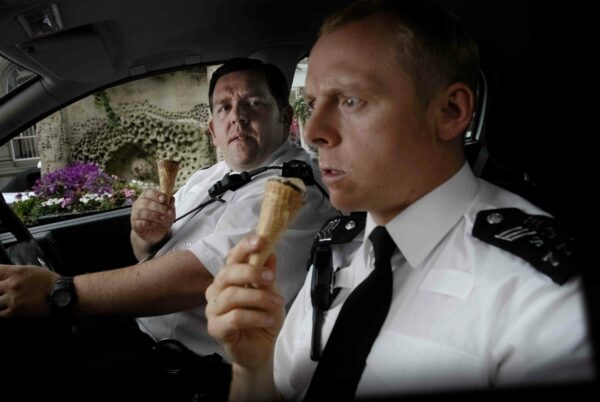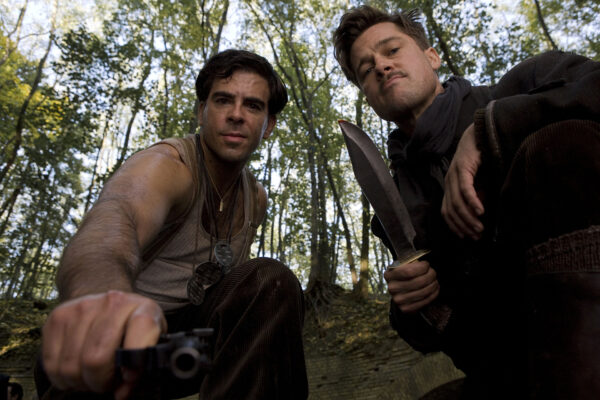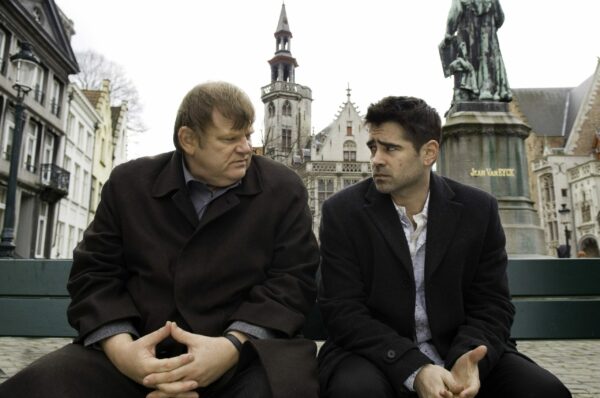
With two iconic performances from Bruce Willis and Alan Rickman, Die Hard is the ultimate 80s action movie. We’re telling the making of story through 20 interesting facts.
Released on July 12th 1988, expectations were low for Die Hard. Despite having a TV star in the lead and initial mixed reviews, it grossed more than five times its budget. The story of a New York cop trying to repair his marriage, who faces off against a gang of crack international terrorists in an LA skyscraper is now considered one of the greatest action films ever made.
Conversations rage around the holiday season regarding its status as a Christmas film. But one thing is for sure, it has a fascinating behind the scenes story which we have for you right here, by way of 20 interesting facts.
1. John McClane could have been played by a legendary crooner
Die Hard was adapted from the Roderick Thorp 1979 novel, Nothing Lasts Forever. It was a follow up to his 1966 work The Detective, which was adapted as a Frank Sinatra vehicle in 1968. As a result, Frank Sinatra was contractually obliged first refusal on any script of the film adaptation of the novel Nothing Lasts Forever. As expected, and a relief to all involved, he declined saying “I’m too old & too rich.”
The trailer for The Detective (1968)
2. Legendary movie producer Joel Silver flexed his muscles on set
Once the script was greenlit, Joel Silver was brought on board to produce. In his first meeting with screenwriter Jeb Stuart, he said “it’s nothing personal, but you’re going to get fired. You are fired! This has nothing to do with the script, I love the script, but I don’t know you. I gotta make a movie & I gotta make a movie fast, this is how it’s gonna be.” However, the film’s other producer Lawrence Gordon protected Stuart and kept him on for further re-writes.
3. Re-writes changed the tone of the original screenplay
Steven E. de Souza was brought on to inject some light into the script. Stuart’s re-writes were faithful to the book’s tone, which had McClane’s daughter mixed up with cocaine and Chilean fascists. De Souza removed some of the darkness from the script and added the light interplay between McClane and Gruber. He also wrote new characters like Uli (Al Leong) and security guard Eddie (Dennis Hayden).
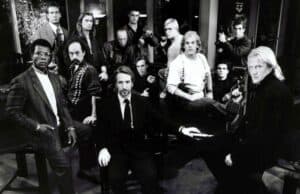
Hans Gruber and his crew
4. Shane Black was responsible for the movie title
The title of Die Hard came from Lethal Weapon (1987) writer Shane Black. It was his original title for The Last Boy Scout (1991) but Joel Silver managed to convince him to hand it over when they worked together on Predator (1987). Nothing Lasts Forever author Roderick Thorpe was furious about the name change. He confronted Silver who told him “the best thing that ever happened to your book is this movie.”
5. Yippee-ki-yay
It’s disputed who came up with the “yippee-ki-yay” line. De Souza claims it was his. Willis said he said it to crack up the crew, but didn’t think that it would make the final cut. The term itself is a reference to a lyric in the Bing Crosby song I’m An Old Cowhand, covered by Roy Rogers in the film King Of The Cowboys (1943).
McClane delivers his iconic line
6. Frank Lloyd Wright provided some unexpected inspiration for the production design
The atrium (the area with the water feature where all the hostages are held) was based on noted architect Frank Lloyd Wright’s Fallingwater (a house he designed for the Kaufmann family); Joel Silver was a huge fan of Lloyd Wright’s work. It was the most expensive set in the whole production. The model bridge in Takagi’s office is an unrealized Frank Lloyd Wright design (The Butterfly Bridge) from 1953. It was a bridge that connected San Francisco to Oakland. Production designer Jackson De Govia found it in a Frank Lloyd Wright book and had it shipped from Lloyd Wright’s Arizona residence.
The model bridge in Takagi’s office
7. John McTiernan was inspired by William Shakespeare
Director John McTiernan saw Die Hard playing out like A Midsummer Night’s Dream, a festival night where everyone’s involved. In his mind he made the festival Christmas and turned it upside down. The princes in the story become fools, like making the FBI and police look stupid. The fools in the story become princes, like Powell and Argyle. Then the next day, the world goes back to normal with the lovers reunited. McTiernan didn’t want to tell producer Joel Silver that he saw it like this for fear of being fired.
8. A mistake during filming impacted the continuity of the film
During the first screening for Fox executives, McTiernan noticed that there was a mistake in the scene where Hans and his crew walk out of the back of the truck when they arrive. There was nothing behind them in the truck but there should have been the ambulance that Theo drives out later in the film. Without the option of digitally adding an ambulance, McTiernan decided to trim the scene down.
This caused a ripple effect on the film because there were key elements that had to go as a result. The cut scene showed Hans and his crew synchronize their watches, here it’s established that they have the same timepiece. Later McClane would notice that all the terrorists he kills have the same watch, including the scene when he first meets Hans when he poses as Bill Clay.
9. Casting Bruce Willis created a stir in Hollywood
Joel Silver was on a flight with agent Arnold Rifkin, and the topic turned to his client Bruce Willis, who was a TV star from Moonlighting. Silver thought Willis had a similar kind of swagger that Mel Gibson and James Cagney had. Initially Willis couldn’t do it because of his Moonlighting schedule, but Cybil Shepherd (his TV co-star) fell pregnant and Willis was on board. Willis said “if I had got Cybil Shepherd pregnant myself, I couldn’t have planned it better.”
He was paid $5 million for the role which raised a lot of eyebrows and had a lasting impact on the industry. The controversy was that a TV star with one movie under his belt could get this amount of money. Wills said “the next day, every actor’s salary rose to $5 million, I didn’t get a Christmas card or anything.”
Bruce Willis in Moonlighting
10. Alan Rickman thought he was going to be fired on set
Casting director Jackie Burch wanted Rickman to play Hans from the get go. She became aware of him from a submission of his she received when she was casting Red Heat (1988); he wanted to play a Russian heavy. A theatre actor, Die Hard was Rickman’s movie debut and he was nervous in the early days of shooting that he was going to get fired. He’d heard whispers that there were concerns that he couldn’t fire a gun without blinking and the studio saw rushes of the scene with Rickman & Willis and thought that he was too weak. Joel Silver and cinematographer Jan de Bont stuck up for him saying that “there’s something interesting going on here.”
11. Hans, Bubbe!
There was a lot of improvisation in the scene where Hans and Ellis (Hart Bochner) meet. Rickman and Bochner were bouncing ideas around, and one of the most significant ideas was Bochner’s “Hans Bubbe!” He improvised the “bubbe” part, thinking “it would be fun to throw a little Yiddish in there.” McTiernan hated what Bochner was doing and told him to tone it down, he saw Ellis as a suave Cary Grant type character. Joel Silver loved it however, so the iconic line stayed in.
Coincidentally, Lloyd Bochner (Hart’s dad) was in The Detective (1968) with Sinatra.
Hans and Ellis meet
12. Rickman’s American accent was a hit with the crew
Rickman’s most significant contribution to the screenplay was to facilitate the first meeting between Hans & McClane. Screenwriter de Souza thought that they needed to have this scene but couldn’t work out how. On set, Rickman was asked if he could do an American accent, he did his best Californian and the crew loved it.
This gave De Souza the idea to construct this scene between the two leads, originally this was going to be between Theo & McClane but de Souza pushed McTiernan to change things around. Thankfully the scene where Takagi dies hadn’t been shot (it was due to be shot the next day), so McTiernan amended the scene so that McClane’s view of Gruber was obscured, allowing this pivotal scene to take place.
13. Rickman injured himself during the first meeting between Gruber and McClane
During the scene where Hans has to scale the wall to check the explosives then jumps down and lands at McClane’s feet, Rickman felt a crack in his knee when he landed. He went to the hospital and came back on set with crutches and a cast on his leg. When filming the moment where he has a cigarette with McClane, Joel Silver visited the set and saw Rickman in his crutches and plaster and said “can we lose the crutches for the next shot?” Rickman was standing on one leg when he was holding the gun to McClane in this scene.
Hans and McClane come face to face
14. Nine million terrorists in the world and I’ve gotta kill one with feet smaller than my sister
Safety glass was used in the scene where Karl and Hans shoot the glass. For added safety, Willis had to wear silicone boots to perfectly mould to his feet, they had a hard rubber sole but were like slippers. The make-up team worked to have them blend into Willis’ skin, and you can just make them out in the mid-shots of Willis in this scene.
Karl and Hans shooting the glass
15. Kubrick’s A Clockwork Orange inspired the music in the film
McTiernan’s goal was to bring some joy to the script and the film. He’d had this piece of music in his head for a while, which he knew from A Clockwork Orange (1971), and knew that he wanted to use it. It wasn’t until a few months later that he realised that it was called Ode To Joy. Composer Michael Kamen wasn’t bowled over at first but came around to the idea, and also suggested to use another piece from A Clockwork Orange (1971), Singing In The Rain. This is subtly woven into the score and can be heard during the SWAT team’s attack, the missile destruction of the armoured vehicle and when Theo is destroying the computer (he’s aggressively humming it).
Theo humming Singing In The Rain
16. I promise I will never even think about going up in a tall building again
McClane fire hose jump was largely completed on set. Stuntman Ken Bates filled in for Willis and a decelerator was used to control the descent. Bates was on wires and a pulley system and the decelerator allowed him to safely free fall, the mechanism kicks in at 50 feet from the ground and comes to a controlled stop.
Willis did his bit in the stunt. The moment where he jumps from the roof was done at a carpark roof dressed to look like the top of Fox Plaza. The roof was rigged with mortars and Willis’ back was padded and his skin was covered in protective gel to absorb the heat. The jump was 25 feet down to the bottom where he landed on an airbag, Silver and McTiernan did the drop first to show how safe it was. The blast from the mortars pushed Willis to the far edge of the airbag; he just made it.
McClane jumps from the roof of Nakatomi Plaza
17. Rickman was caught unaware when he dropped from the top of Nakatomi Tower
McTiernan persuaded Rickman to do this stunt himself and he had to go through training to learn how to fall backwards. He had to bring the gun up whilst also remembering to spread his arms and legs to allow for a safe landing. If he didn’t, his body would likely turn and he would land on his head. The stunt was performed on stage with a blue screen background that was replaced with a shot taken from the upper floors of Fox Plaza
McTiernan did it first, again to show how safe it was. The effects co-ordinator said that the rig operator would drop him at the count of three but secretly arranged to drop him on one to capture genuine fear and terror in Rickman’s eyes. They did a second take, but it was take one that made it into the film.
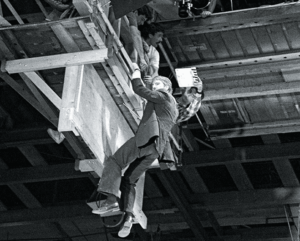
Alan Rickman performing his stunt
18. McTiernan and cinematographer Jan de Bont decided to give Die Hard a fresh, modern look
More realistic than other films around the time, they decided to apply a documentary style approach, so the action felt like real life and the camera just happened to be there. De Bont said “the camera had to be like a floating bystander. Every time you saw something, the camera could almost intuitively move left or right, up or down”
McTiernan also used a technique of cutting from one shot to another while the camera is moving. Conventionally, cuts happened in film with the camera not moving. McTiernan conceived this like a musical composition, how you do it is to have both shots essentially in the same key.
19. The C4 fireball scene was shot using a 23-foot model
The scene obviously couldn’t be done on an actual 30 storey elevator shaft, so special effects co-ordinator Richard Edlund and his crew created a 23-foot-high replica that tapered to the ground to create the illusion that it was actual size. The top was 4 x 6 feet and the bottom was 6 x 9 inches. Tiny lights and pipework were added and every elevator door and shaft were hand painted to scale, gradually diminishing in size as they got to the bottom.
The fireball was created by using fire-resistant paint and chemicals that would burn slowly. The blast was too fast to replicate a 30-story fireball and was shot frame by frame, with repairs being made to the fire damaged interior along the way. McTiernan had the idea to shoot the bottom of the blast as is, then turn the camera off. It would continue to run briefly using its own momentum before coming to a natural stop. Because of this the film ran through the camera more slowly, decreasing the frame rate. After all the frames were edited together and ran at normal speed, it made the fireball look like it was moving much faster as it rises.
The C4 fireball scene
20. Bruce Willis wasn’t a marketable star
Fox weren’t sure how to market the film and 2 weeks before release, decided on a one sheet without Willis’ face on it, concluding that the building was the star and an actor known for comedy would not sell an action film. Two weeks after it opened, having been a massive success, Fox decided to put Willis’ face back on the poster.
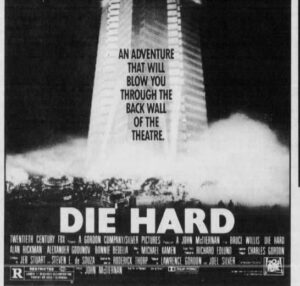
The original movie poster for Die Hard
And we’re at the end of our list – 20 huge, spectacular and fun facts about Die Hard – one of the best action movies ever made. Please share on your social media platforms, and subscribe to our YouTube channel for lots of great video content.
The beginning of a beautiful friendship
Stay up-to-date with all things All The Right Movies by signing up for our e-newsletter.
